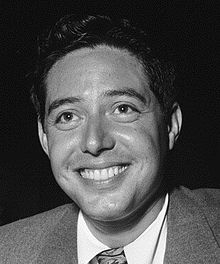This article has multiple issues. Please help improve it or discuss these issues on the talk page. (Learn how and when to remove these messages)
|
Andy Russell | |
|---|---|
 Russell in 1947 | |
| Born | Andrés Rábago September 16, 1919 Los Angeles, California, US |
| Died | April 16, 1992 (aged 72) |
| Occupation(s) | Vocalist Percussionist Radio host Radio actor and singer Television singer Motion picture actor and singer Television variety show host Nightclub singer |
| Years active | 1934–1989 |
| Spouse(s) | Evelyn Marie Morse (1940–1945) Della Russell (1945–1954) Velia Sánchez Belmont (1954–1961) Virginia "Ginny" Pace (1967–1987) Doris E. Russell (?–1992, his death) |
| Musical career | |
| Genres | Traditional pop, Latin music, big band, swing, easy listening |
| Instrument(s) | Vocals, drums |
| Labels | Capitol, RCA Victor, Orfeon, Belter/Divusca |
Andy Russell (born Andrés Rábago;[1] September 16, 1919 – April 16, 1992) was an American popular vocalist, actor, and entertainer of Mexican descent, specializing in traditional pop and Latin music. He sold 8 million records in the 1940s[2] singing in a romantic, baritone voice and in his trademark bilingual English and Spanish style.[3][4] He had chart-busters, such as "Bésame Mucho", "Amor", and "What a Diff'rence a Day Made". He made personal appearances and performed on radio programs, most notably Your Hit Parade, in several movies, and on television. During this initial phase of his career, his popularity in the United States rivaled that of crooners Frank Sinatra and Perry Como.
In 1954, he relocated to Mexico where he became a star of radio, television, motion pictures, records and nightclubs. He toured extensively throughout Latin America, Spain, Portugal and Cuba,[4] and hosted the television variety program El Show de Andy Russell in Argentina from 1956 to 1965.[5]
Upon returning to the United States, Russell continued to record. His 1967 single "It's Such a Pretty World Today" reached #1 on Billboard Magazine's Easy Listening Chart.[6] In the ensuing years, Russell continued to perform in the United States and around the world, occasionally recording new records and making television appearances. Although well received, he did not achieve his previous level of success.[7][8]
During his 50-year career, Russell received many international accolades and awards, most notably being recognized as the original Latino crossover artist[9] who introduced American audiences to popular songs sung in English and Spanish,[10] thus opening the doors for later Hispanic bilingual artists to do the same.[9][11] Through a fusion of musical styles, rhythms and languages, he created music that transcended borders and appealed to diverse audiences, becoming one of the first cross-cultural, multinational musical artists.[12]
- ^ Cite error: The named reference
birthwas invoked but never defined (see the help page). - ^ Loza, Steven (1993). Barrio Rhythm: Mexican American Music in Los Angeles. University of Illinois Press. p. 80. ISBN 9780252062889.
eight million.
- ^ Lamparski, Richard (1985). Whatever became of ... ?. Crown Publishers Inc. p. 150. ISBN 0-517-55540-9.
- ^ a b Cite error: The named reference
hernanwas invoked but never defined (see the help page). - ^ Cite error: The named reference
loza143was invoked but never defined (see the help page). - ^ "Andy Russell Disney's Star". The Evening Independent. October 12, 1972. p. 9B. Retrieved June 18, 2014.
- ^ Cite error: The named reference
myrnawas invoked but never defined (see the help page). - ^ "Obituaries, Andy Russell Who Sang 'Besame Mucho'". The Seattle Times. April 17, 1992. Retrieved June 20, 2014.
- ^ a b Arthur Bernstein; Naoki Sekine; Dick Weissman (2007). The Global Music Industry: Three Perspectives. New York: Routledge. p. 82. ISBN 978-0415975803. Retrieved 10 October 2014.
- ^ Cite error: The named reference
training groundwas invoked but never defined (see the help page). - ^ Laredo, Joseph F. (1995). Liner Notes from Spotlight on Andy Russell CD. Los Angeles: Capitol Records, Inc. p. 6.
- ^ Horn, David (2012). Shepherd, John (ed.). Continuum Encyclopedia of Popular Music of the World Volume 8: Genres: North America (1 ed.). The Continuum International Publishing Group. p. 132. ISBN 978-1441160782. Retrieved 22 October 2014.